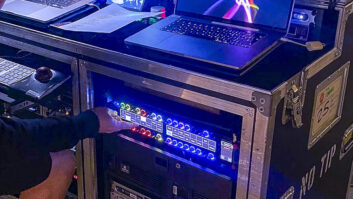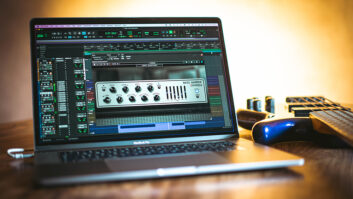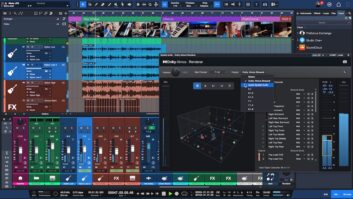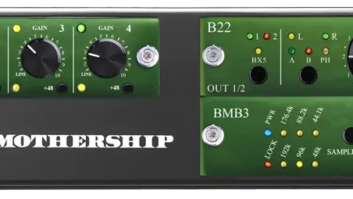The U95S is the latest microphone in the growing Soundelux line,
features audiophile grade electronic components throughout and is
designed to be the flagship of the Soundelux fleet.
According to designer David Bock, the U95S is a no-compromise
design. The centerpiece of the mic is its capsule, a copy of the KK47
capsule developed by Neumann for its U47 and M49 microphones. The U95S
capsule is manufactured in Latvia by BLUE; Soundelux feels this is the
most advanced version ever built of that timeless design. The capsule
feeds an EF86 pentode that is operated as a triode in a common cathode
configuration. From there, the signal passes through a custom-designed
transformer that is enormous compared to what is usually found inside a
microphone.
The overriding theme in the U95S is to maximize headroom throughout
the signal path. The classic mics built with this capsule design were
developed for more distant recording applications. Recording techniques
developed for modern popular music have often placed those older mics
in some very high-SPL situations. Other tube circuits, in general, have
posed problems in maintaining linear behavior. Soundelux has designed
the U95S circuit around a very high voltage supply to avoid any such
problems. The transformer is designed to stay out of saturation for
signals up to +4 dBu! As the mic does not have a low-frequency roll-off switch or a capsule attenuator, and
because the capsule is capable of picking up infrasonic signals, such a
large transformer is necessary to ensure that the mic consistently
delivers a clean output. Other designs have neglected this essential
aspect. The transformer is also a very wide bandwidth device, with its
-3dB point at 45 kHz.
The EF86 (a.k.a. 6267) is a tube that has found its way into many
designs, but it is often used in very different ways. The venerable
U67, for example, uses it in a circuit that has a novel approach to attenuation and filtering. That circuit has a
great deal of negative feedback. For Soundelux to use the EF86 as a
triode is not as strange as you might think. The curves for an EF86
operated in triode mode are much more linear than for most other tubes
that were initially designed as triodes. Also, the design of the EF86
specifies an internal shield that enhances its electromagnetic
shielding. In many applications, an external shield hood is not
necessary. Soundelux chose a modern Svetlana tube that is superior in
both shielding and linearity over the conventional EF86.
Some tubes used in condenser mics are connected as cathode followers.
This configuration has no net gain but provides a lower-output impedance and the least distortion. Soundelux
opted for the common cathode arrangement that results in more of the
tube’s color being retained. Since no loop feedback is used, there is
no possibility of encountering the transient intermodulation
distortion, or TIM, that has plagued other designs that might also
measure well. The only penalty I could see with this configuration is
the possibility that variations among individual tubes may result in
differing gains and sonic attributes. According to Dave Bock, the tubes
are hand-selected, so the effect should be minimal, but I decided to
make a point of checking it just the same.
All of the U95S microphones come supplied with a spare tube. I
swapped the original tube with the replacement and found there was
little, if any, difference. I also swapped in an EF86 that I was using
in one of my own microphones. There was a very mild gain change, much
less than I expected, but most notable was increased microphonics-the
noise that comes from the internal elements of the vacuum tube
vibrating when the tube is tapped or shaken. I also found that the
Svetlana tube was less sensitive to hum, thanks to superior shielding.
However, once enclosed inside the mic housing that made no difference,
but it is indicative of the higher level of quality in the new Russian
tubes.
The U95S is capable of being switched to any of the common pickup
patterns. This is done via remote control at the power supply. It took
several seconds for the pattern change to take place. This is a direct
indicator of the low-frequency limit in the capsule circuit (and it is
a good way to check for a failing capsule). The figure-8 pattern nulled
precisely where it should, which shows the capsule diaphragms are
well-matched.
I directly compared the mic to the best of my classic Telefunken U47
mics that use the same capsule design. At identical gains, the noise
was noticeably lower, with no signs of popping or sputtering.
In session on vocals, the sound was enormous. It comes as no
surprise that this is not a neutral mic. On the cardioid setting it gives generous amounts of proximity effect when worked up close. As with its
classic ancestors, a sharp edge is etched to the upper reaches of the
vocal range if addressed directly on axis, with a smoothly tailored
reduction of that effect as a slight angle is introduced. What is
unique to the sound is extremely low distortion and a rich, deep bass.
I can imagine it useful in any of the applications where a classic mic
would be placed, expecting added cleanliness as the only major
difference.
I also loaned the mic to a local engineer, who put it up alongside a
Stephen Paul-modified AKG C24 for a vocal session. The client did not
hesitate to choose the Soundelux for the session. The studio also
arranged to buy my sample unit!
The mic I tested was an early production unit that had some minor
fit and finish problems in the power supply, but I am told that those
anomalies have been rectified. My only major complaint with this mic
was with the shock mount, which was not only ineffective but actually
caused a mechanical resonance, with an audible pitch around 200 Hz. I
recommend using the supplied fixed stand adapter, along with taking
care to avoid stand vibrations.
The rest of the mic was well-crafted, and is dressed out with an
attractive black chrome trim. It comes in a solid wood case, and the
entire system is ready to travel in a high-impact plastic waterproof
field case. When compared to the going street price of a classic mic,
complete with its old-technology flaws, or even a new mic that uses a
similar capsule configuration, it is surprising that a no-compromise
design can sell at a list price of only $3,600. If you are interested
in the color of the classic “Tele,” with all the rough edges polished
to precision, the Soundelux U95S deserves your attention.
Soundelux Microphones, www.soundeluxmics.com







